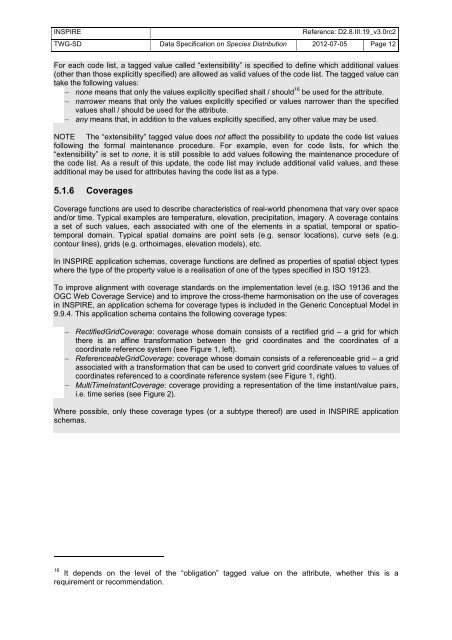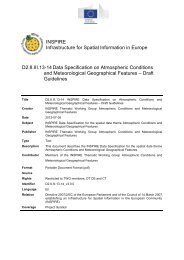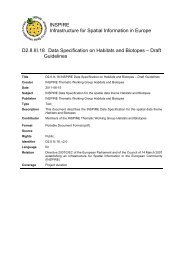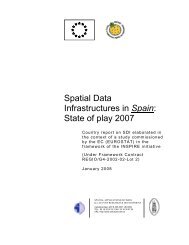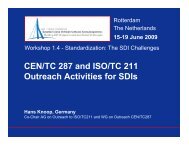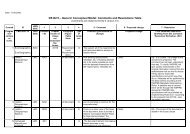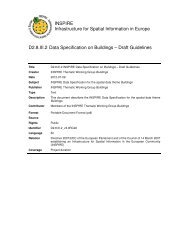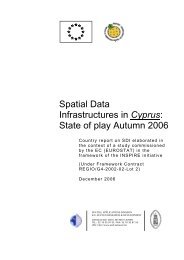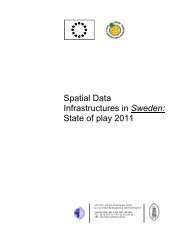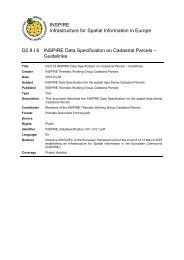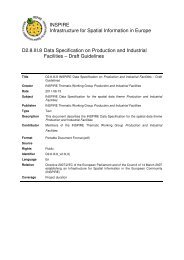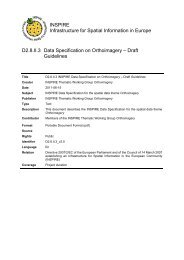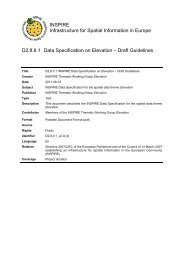Download Version 3.0 rc2 - Inspire - Europa
Download Version 3.0 rc2 - Inspire - Europa
Download Version 3.0 rc2 - Inspire - Europa
Create successful ePaper yourself
Turn your PDF publications into a flip-book with our unique Google optimized e-Paper software.
INSPIRE Reference: D2.8.III.19_v<strong>3.0</strong><strong>rc2</strong><br />
TWG-SD Data Specification on Species Distribution 2012-07-05 Page 12<br />
For each code list, a tagged value called “extensibility” is specified to define which additional values<br />
(other than those explicitly specified) are allowed as valid values of the code list. The tagged value can<br />
take the following values:<br />
− none means that only the values explicitly specified shall / should 16 be used for the attribute.<br />
− narrower means that only the values explicitly specified or values narrower than the specified<br />
values shall / should be used for the attribute.<br />
− any means that, in addition to the values explicitly specified, any other value may be used.<br />
NOTE The “extensibility” tagged value does not affect the possibility to update the code list values<br />
following the formal maintenance procedure. For example, even for code lists, for which the<br />
“extensibility” is set to none, it is still possible to add values following the maintenance procedure of<br />
the code list. As a result of this update, the code list may include additional valid values, and these<br />
additional may be used for attributes having the code list as a type.<br />
5.1.6 Coverages<br />
Coverage functions are used to describe characteristics of real-world phenomena that vary over space<br />
and/or time. Typical examples are temperature, elevation, precipitation, imagery. A coverage contains<br />
a set of such values, each associated with one of the elements in a spatial, temporal or spatiotemporal<br />
domain. Typical spatial domains are point sets (e.g. sensor locations), curve sets (e.g.<br />
contour lines), grids (e.g. orthoimages, elevation models), etc.<br />
In INSPIRE application schemas, coverage functions are defined as properties of spatial object types<br />
where the type of the property value is a realisation of one of the types specified in ISO 19123.<br />
To improve alignment with coverage standards on the implementation level (e.g. ISO 19136 and the<br />
OGC Web Coverage Service) and to improve the cross-theme harmonisation on the use of coverages<br />
in INSPIRE, an application schema for coverage types is included in the Generic Conceptual Model in<br />
9.9.4. This application schema contains the following coverage types:<br />
− RectifiedGridCoverage: coverage whose domain consists of a rectified grid – a grid for which<br />
there is an affine transformation between the grid coordinates and the coordinates of a<br />
coordinate reference system (see Figure 1, left).<br />
− ReferenceableGridCoverage: coverage whose domain consists of a referenceable grid – a grid<br />
associated with a transformation that can be used to convert grid coordinate values to values of<br />
coordinates referenced to a coordinate reference system (see Figure 1, right).<br />
− MultiTimeInstantCoverage: coverage providing a representation of the time instant/value pairs,<br />
i.e. time series (see Figure 2).<br />
Where possible, only these coverage types (or a subtype thereof) are used in INSPIRE application<br />
schemas.<br />
16 It depends on the level of the “obligation” tagged value on the attribute, whether this is a<br />
requirement or recommendation.


